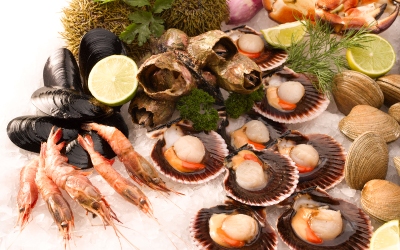Over recent years the levels of fish and seafood consumption has increased dramatically, partly due to the concerns about fat and cholesterol in our diets. Because fish is seen as the healthier and low fat option, people are choosing it far more over red meat – it also offers bountiful doses of heart-healthy omega-3 fatty acids, which is an added bonus to our health. As this has increased, so too have the numbers of people who are allergic to it. Fish allergies affect around one in 200 people, and shellfish allergy symptoms (such as prawns and crabs) are more common with one percent of the population in significant shellfish consumptions. A seafood allergy is more common amongst adults than children, and isn’t as common as milk or peanut allergies. Those who have an allergy to this form of food tend to have it for the rest of their lives. But how can you spot it?
As with other foods, the symptoms include nausea and sickness, abdominal cramps, wheezing, flushing or swelling of the skin, urticarial rashes and diarrhoea, and even fatalities in some extreme cases. It’s fairly uncommon for people to have an allergic reaction to just the smell of a food, though many people complain of such a symptom. However, in shellfish allergies, this is not the case – around 15 percent of people with a seafood allergy can react just to vapours and steam produced during cooking, in particular with BBQ and grilling. This is a chemical reaction, as fish and shellfish release small proteins known as amines during cooking, which lead to people inhaling them. This causes a reaction that’s quite unlike other food allergies. Surveys suggest that after nut allergies, seafood is the most common for severe reactions, known as anaphylaxis. In a report based on 167 children with seafood allergies, over one in five had experienced a severe reaction to the food.
Most people with allergies to crustaceans, such as prawns, are still able to eat finned fish. Similarly, people who are allergic to tuna can often eat prawns – a cross-reactivity within a class is common, though, for some people who are allergic to a fish such as salmon generally have to avoid all finned fish. This is the same for people with a crustacean-allergy when eating oysters and squid, as studies suggest that there could be cross-sensitivity with these foods. This cross-reactivity tends to be more common in children than adults – it’s for this reason that children with seafood allergies need an allergy assessment in order to determine which other forms of fish and shellfish that are allergic to and need to avoid.
If you notice that you get symptoms akin to other allergies when fish or seafood is cooking, this can be a sign, as previously mentioned. Patients with a long history of severe reactions to crustacea should avoid locations where these foods are cooked and served, as it can trigger allergic reactions which could prove to be fatal in severe cases. Interestingly, reports suggest that up to 20 percent of people who are allergic to fish can tolerate it when it is canned, such as tuna. The canning process involves extensive heating in order to preserve the food, which can destroy the protein that many are allergic to. However, it’s not worth risking it as four out of five people will still have a reaction. If you suspect you may have an allergy to fish or shellfish, it’s worth speaking to your GP in order to determine if this is the case. You may require an allergy testing in order to diagnose it.
